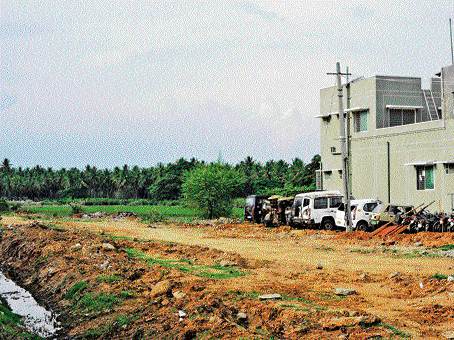
There seem to be two standards in the scheme of things: one for the common man and the other for the government’s own departments.
Structures that had come up illegally on the Banaswadi Lake in Bengaluru were recently removed. So were the encroachments on Sarakki lakebed, which were demolished earlier last month. But the powers that be seem not bothered about the buildings for government offices on the Kanakapura lake in the not-so-far-away Ramanagar district.
The land on the lakebed had been allotted for the construction of government offices, says F R Jamadar, Deputy Commissioner, Ramanagar. However, when this was questioned in the High Court, no objections were raised.
“The High Court has listed the offices which have come up on the lakebed. What we can do is ensure that there are no more encroachments. The task is to protect the remaining 20 acres of lake land,” he said.
In 2012, the Revenue department, Ramanagar deputy commissioner’s office and the Kanakapura taluk office allotted 16 acres and 29 guntas (out of 36 acres and 26 guntas) of the Kanakapura lakebed, situated on Survey Number 505 of Kanakapura town, for the construction of several public offices. The order for the same was issued on January 20 that year.
Some of the public buildings planned to be constructed on the allotted land include offices for the Horticulture department, Women and Child Development department and the Agriculture Produce Marketing Committee, besides a temple. The government’s largesse made the lake land shrink from 36 acres and 26 guntas to 20-odd acres. According to officials, the land allotment has been done in a manner that divides the lake haphazardly. A road, connecting the public offices, has also been sanctioned on the lake land. Hardly 10 acres of the lake is filled with water and the rest has dried up, it is said.
In 2012, a public interest litigation was filed in the High Court by Sampath Kumar, a resident of Kanakapura, questioning the government order on creating sites on the lakebed.
The government, in its response, had argued that the feeder channels to the lake were affected on account of residential layouts in the vicinity. The lakebed had become a breeding ground for mosquitoes due to stagnation of sewage water.
Considering these aspects and the fact that the lake has lost its characteristic features, the government decided that the lakebed could be utilised for other purposes.
The court, in its order, noted that the government committed an illegal act by passing a gazetted order in 2003 that changed the Record of Rights, Tenancy and Crop (RTC) and the characteristics of the land which formed the Kanakapura lake. The land records were changed by the local administration after it was found that feeder channels to the lake had dried up and the fact that the lake had become a breeding ground for mosquitoes, the division bench which heard the case said.
The division bench, comprising Chief Justice D H Waghela and Justice B V Nagarathna, dismissed the petition, citing that the petitioner approached the court in 2012, while the changes in the RTC were made in 2003.
“Having regard to these reasons, we are of the view that at this point in time, it would not be appropriate to interfere with the various allotments made by the government to an extent of 16 acres and 29 guntas,” read the order.
Incidentally, the Sarakki Lake order directing demolition of illegal structures was passed by Chief Justice D H Waghela and Justice Ashok B Hinchigeri.